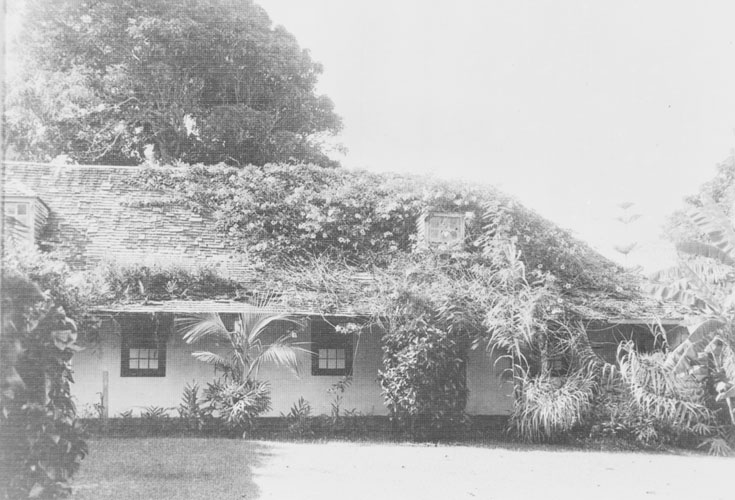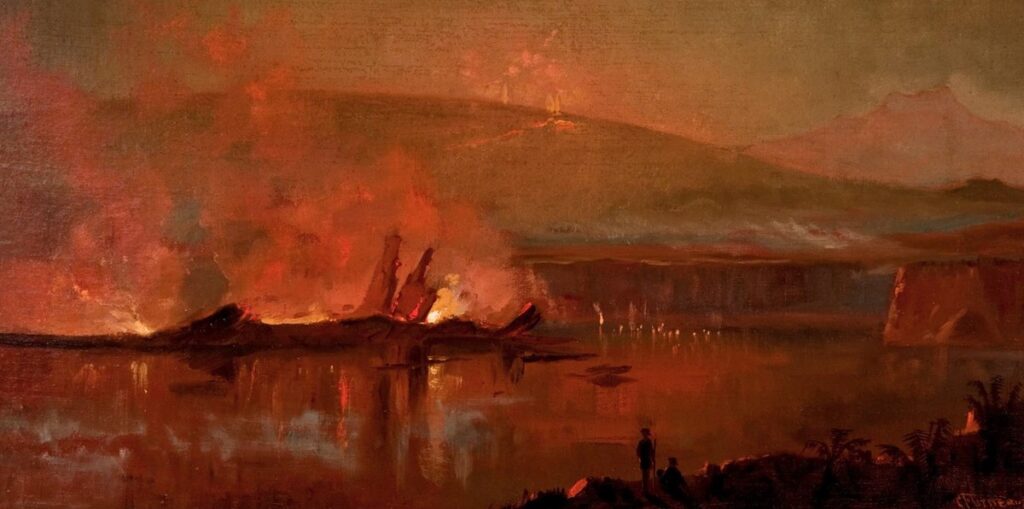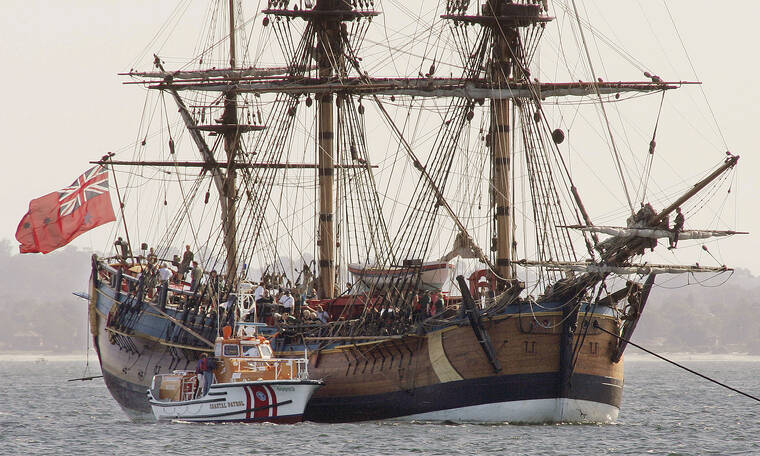The first corporation granted a charter by the Hawaiian government were Punahou School, on June 6, 1849. (Schmitt)
In anticipation of the future growth of the Kingdom, in 1853 a new and enlarged charter was applied for and granted by the government to the Trustees of ‘the Punahou School and Oahu College.’ This granted the formation of Oahu College, which would offer two years of advanced coursework and delay students’ departures for U.S. colleges. (Punahou)
At the Privy Council meeting on May 23, 1853, Mr. Armstrong read the Charter of the Punahou School. After which state, in part:
“Resolved; That a Charter of incorporation for a school and Prospective College at Punahou, near Honolulu having been submitted to this council by the Minister of the Interior for the concurrence of the council in granting the same, said Minister is hereby authorized & empowered to grant said Charter to the persons therein named.”
In the 1856 Annual Report of the American Board of Commissioners for Foreign Missions noted that, “The aim which the Board and its fellow-laborers at the Sandwich Islands have in view …”
“… is to assimilate the religious and educational institutions of the Hawaiian Christian community, in their constitution and methods of support, as nearly as possible to what exists in the newly occupied districts of our own country.”
“Of course, but a portion of the new Christian institutions will, for a time, find their full support at the Islands. It is desirable, were it possible, that a greater proportion of the island resources be devoted to the support of pastors, preachers and teachers of native growth …”
“… thus rooting the institutions of the gospel more speedily and firmly in the soil. We should be thankful, however, for the unexampled progress already made at these Islands.” It goes on to state,
“The ‘Oahu College’ was mentioned in the last Report. It has grown out of the Punahou school, commenced in 1841 for the children of the missionaries. Five years ago that school was opened to others besides the children of missionaries.”
“In May, 1853, the Hawaiian Government converted it into a College, by incorporating a Board of Trustees for ‘the Training of Youth in the various branches of a Christian education.’”
The charter further states, that, “as it is reasonable that the Christian education should be in conformity to the general views of the founders and patrons of the institution …”
“… no course of instruction shall be deemed lawful in said institution, which is not accordant with the principles of Protestant Evangelical Christianity, as held by that body of Protestant Christians in the United States of America, which originated the Christian mission to the Islands, and to whose labors and benevolent contributions the people of these Islands are so greatly indebted.”
There is also an additional security for the institution in the following article, namely: “Whenever a vacancy shall occur in said corporation, it shall be the duty of the Trustees to fill the same with all reasonable and convenient dispatch.”
“And every new election shall be immediately made known to the Prudential Committee of the American Board of Commissioners for Foreign Missions, and be subject to their approval or rejection; and this power of revision shall be continued to the American Board for twenty years from the date of this charter.”
“The Prudential Committee regard this institution as essential to the development and continued existence of the Hawaiian nation. ‘It is so because the missionary portion is really the palladium of the nation, and because a college is essential to that part of the community.’”
“The religious foreign community cannot otherwise long continue to perform its functions. It must have the means of liberally educating its children on the ground.”
“Without a college, its moral, social and civil influence will tend constantly to decay. This most precious Christian influence, now rooted on the Islands, now no longer exotic, needs only the proper culture to perpetuate itself.”
“The cheapest thing we can do for the Islands and for that part of the world, is to furnish this culture. It is better to educate our ministry there, than to send it thither from these remote shores. Indeed we are shut up to this, as our main policy.”
“The time is come for the reasonable endowment of this institution, which of course must be effected, if at all, chiefly in this country; and $50,000 are asked for this purpose by the Trustees.”
“It is interesting to know that the Hawaiian Government has engaged to give $10,000, or one-fifth of the whole, in case $40,000 more are secured by July 6, 1858.”
“The Prudential Committee have voted to subscribe $5,000, on behalf of the Board, towards this endowment; and also to pay the salaries of the President and a Professor for the years 1856 and 1857.”
“Meanwhile they commend the object most cordially to the benevolent in the United States, and especially to those large-hearted merchants whose wealth has been chiefly derived from the Pacific Ocean.” 1856 Annual Report ABCFM)
Dr Rufus Anderson, Foreign Secretary of the American Board of Commissioners for Foreign Missions traveled from Boston to Hawai‘i to attend the annual meeting of the Hawaiian Evangelical Association (the name attributed to the Hawaiian Mission). The General Meeting was held from June 3, 1863 to July 1, 1863.
Subsequent meeting minutes and other references noted that, “Dr. Anderson having recently returned from a visit to the Sandwich Islands, which he made at the special request of the Prudential Committee … for the purpose of ascertaining, by personal intercourse with the missionaries, the members of their churches, and the people generally to whom they had ministered, more fully than could be done in any other way, …”
“… the real condition of the people, the state of the churches, and the character of their members, and witnessing on the ground the results effected among the people of the Islands by the power and Spirit of God, through the labors of the missionaries; …”
“… for the further purpose of freely conferring and advising with the missionaries, and with members of the Hawaiian churches, upon the present condition and further prospects of the missionary work there …”
“… and devising such plans of future action, as should bring the native churches, as speedily as possible, in what is believed to be the natural order in such cases, (1) to a condition of self-government, and (2) by means of the greater activity and earnestness which would be developed by this self-government, to a condition of complete self-support …”
“… and, also, for the purpose of determining, by such free conference with the missionaries, what may best be their future relations to the Board and its work”. (Action of the Prudential Committee; Proceedings of the Hawaiian Evangelical Association)
“The state of things at the Islands is peculiar. They have been Christianized. The missionaries have become citizens. In a technical sense they no longer are missionaries, but pastors, and as such on an official parity with the native pastors.” (Anderson)
“Nearly one third of the population are members of Protestant churches; the native education is provided for by the government; houses for the worship of God have been everywhere erected, and are preserved by the people; regular Christian congregations assemble on the Sabbath …”
“… and there is all the requisite machinery for the healthful development of the inner life of the nation, and for securing it a place, however humble, among the religious benefactors of the world.”
“In short, we see a Protestant Christian nation in the year 1863 … self-governing in all its departments, and nearly self-supporting. And the Hawaiian nation is on the whole well governed. The laws are good, and appear to be rigidly enforced. The king at the time of this meeting was in declining health, and did not long after.”
“Better educated by far than any of his predecessors, more intelligent, more capable of ruling well, he was subject to strong feeling, and was said to be less an object of veneration and love to his people than was his immediate predecessor.” (Anderson)
The Prudential Committee of the ABCFM “Resolved, That … the Protestant Christian community of the Islands has attained to the position of complete self-support, as to its religious institutions, there is yet ample occasion for gratitude to God for his signal blessing upon this mission”.
It further “Resolved, That the proposition made by the Protestant Christian community at the Sandwich Islands, who have organized a working Board, called ‘The Board of the Hawaiian Evangelical Association,’ to relieve the American Board of Commissioners for Foreign Missions, and the American churches, from the responsibility of future oversight and direction in the work …”
“…And this Committee joyfully commits to the Board of the Hawaiian Evangelical Association the future care and direction of this evangelizing work in those Islands; and hereby concedes to that Board the right of applying for grants-in-aid, as specified in said proposition.” (Action of the ABCFM Prudential Committee)
Anderson wrote to inform Kamehameha IV of the Hawaiian Evangelical actions and dissolution of the mission in his July 6, 1863 letter noting, in part: “I may perhaps be permitted, in view of my peculiar relations to a very large body of the best friends and benefactors of this nation, not to leave without my most respectful aloha to both your Majesties.”
Click the following link for more information on Punahou/Oahu College:
























































